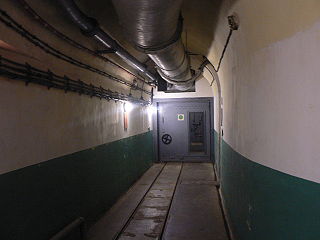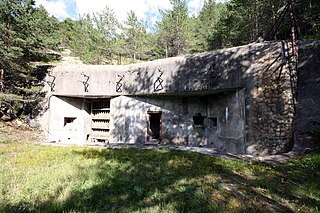
Ouvrage Billig, a gros ouvrage or large fortification of the Maginot Line, was located in the Fortified Sector of Thionville, Moselle in northern France. It is located between the gros ouvrages Metrich and Hackenberg, facing Germany. It saw relatively little action during World War II and after a period of reserve duty in the 1950s, was abandoned in the 1970s.

Ouvrage Bréhain is part of the Fortified Sector of the Crusnes of the Maginot Line, located near the community of Bréhain-la-Ville in the Meurthe-et-Moselle département of France. Bréhain is flanked by petits ouvrages Mauvais Bois and Aumetz. The gros ouvrage was equipped with long-range artillery, and faced the border with Luxembourg. It saw no major action in either the Battle of France in 1940 or the Lorraine Campaign of 1944. While not open to public visitation, it has been secured and is in relatively good condition when compared to other abandoned Maginot positions. A flanking casemate has been restored and may be visited.

Ouvrage Saint-Gobain is a work of the Maginot Line's Alpine extension, the Alpine Line. The ouvrage consists of one entry block, one infantry block, one artillery block, one observation block and one combination block. Located in Modane, France, it is just across the valley of the Arc from Ouvrage Saint-Antoine and somewhat to the east of Ouvrage Sapey.

Ouvrage Saint-Antoine is a work of the Maginot Line's Alpine extension, the Alpine Line. The ouvrage consists of one entry block, one infantry block and one artillery block overlooking Modane on the way to the Col du Mont Cenis. Ouvrage Saint-Gobain is just to the north, across the mountain valley. Saint-Antoine overlooks the approaches to the Fréjus Rail Tunnel and was part of an ensemble of forts, including Saint-Gobain, Ouvrage Sapey and Fort du Replaton that guarded the French end of the tunnel and the descent from the Mont Cenis pass.

Ouvrage Le Lavoir Is a work of the Maginot Line's Alpine extension, the Alpine Line, also called the Little Maginot Line. The ouvrage consists of two entry blocks, one infantry block, three artillery blocks and one observation block 6 kilometres (3.7 mi) south of Modane, France, guarding the Col de Fréjus. The surface barracks at Le Lavoir were connected to Charmaix by an aerial tram.

Ouvrage Pas du Roc is a work of the Maginot Line's Alpine extension, the Alpine Line. The ouvrage consists of one entry blocks, one infantry block, two artillery blocks and one observation block 6 kilometres (3.7 mi) south of Modane and 1.6 kilometres (0.99 mi) east of Ouvrage Le Lavoir in the vicinity of the Col de Fréjus. The position was incomplete at the outbreak of war in 1940.

Ouvrage Col du Granon is a lesser work of the Maginot Line's Alpine extension, the Alpine Line. The ouvrage consists of one entry block, one infantry block and one observation block covering the Col du Granon as part of the defenses of Briançon and Grenoble. The ouvrage lies at an altitude of 2,329 metres (7,641 ft).

Ouvrage Saint Ours Haut is a work of the Maginot Line's Alpine extension, the Alpine Line, also known as the Little Maginot Line. The ouvrage consists of one infantry block, one artillery block, two observation blocks and one combination block in the vicinity of the Col de Larche. It is located on the territory of the commune of Meyronnes. Construction began in March 1931, at a cost of 15.1 million francs.

Ouvrage Col de Restefond is a lesser work of the Maginot Line's Alpine extension, the Alpine Line. The ouvrage consists of three infantry blocks. It is located directly adjacent to the Col de Restefond road at an altitude of 2,680 metres (8,790 ft). Construction work was completed in 1934, but the ouvrage was not armed until 1938.

Ouvrage La Moutière is a lesser work of the Maginot Line's Alpine extension, the Alpine Line at an altitude of 2440 meters. The ouvrage consists of one entry block, one infantry block and one observation block, with an unarmed exit block. The ouvrage supported the Ouvrage Restefond on the crest of the pass, guarding its southern flank. It also covered the Col de la Barcelonnette to the north. The position was built between 1931 and 1935.

Ouvrage Rimplas is a work of the Maginot Line's Alpine extension, the Alpine Line, known also as the Little Maginot Line. The ouvrage consists of one entry block, two infantry blocks and three artillery blocks at an altitude of 986 metres (3,235 ft). It was the first ouvrage of any portion of the Maginot Line to be completed, in 1928. The ouvrage features an aerial tram entrance.

Ouvrage Col du Caire Gros is a lesser work of the Maginot Line's Alpine extension, the Alpine Line. The ouvrage consists of two entry blocks at an altitude of 2,048 metres (6,719 ft). Additional blocks were planned but not built.

Ouvrage Gordolon is a work of the Maginot Line's Alpine extension, the Alpine Line, also known as the Little Maginot Line. The ouvrage consists of one and two infantry blocks at an altitude of 728 metres (2,388 ft). Gordolon was built by Borie contractors at a cost of 21.4 million francs. Work started in November 1931 and was completed in April 1934.

Ouvrage Flaut is a work of the Maginot Line's Alpine extension, the Alpine Line, also called the Little Maginot Line. The ouvrage consists of one entry block, one infantry block and one artillery block at an altitude of 771 metres (2,530 ft). The position was intended, acting with Ouvrage Gordolon, to stop an approach by Italian forces from the north towards Nice through the Vésibie Valley.

Ouvrage Plan Caval is a lesser work of the Maginot Line's Alpine extension, the Alpine Line, also known as the Little Maginot Line. The ouvrage consists of two infantry blocks and one observation block facing Italy. The ouvrage is located on the heights of L'Authion, surrounded by older fortifications. Three additional blocks were planned to make it a gros ouvrage but were not built. Cost for the full ensemble was estimated at 23 million francs.

Ouvrage Col de Brouis is a work of the Maginot Line's Alpine extension, the Alpine Line, also known as the Little Maginot Line. The ouvrage consists of one entry block and two artillery blocks facing Italy at an altitude of 871 metres (2,858 ft). The ouvrage is located about one kilometer north of Monte Grosso. It was placed to control the Col de Brouis and the D 2204 road between the Breil and Sospel.

Ouvrage Monte Grosso is a work of the Maginot Line's Alpine extension, the Alpine Line, also known as the Little Maginot Line. The ouvrage consists of one entry block, four artillery blocks and two observation blocks facing Italy. It was the largest ouvrage in the Alps It is part of the fortifications surrounding Sospel, which protect the approaches to Nice from the north.

Ouvrage Champ de Tir, also known as Champ de Tir de l'Agaisen is a lesser work of the Maginot Line's Alpine extension, the Alpine Line. It is located at an altitude of 672 metres (2,205 ft), less than 1 kilometer to the northwest of Ouvrage l'Agaisen. The ouvrage consists of two entry blocks and one infantry block, sited to control the valley of the Nieya and to observe for l'Agaisen.

Ouvrage Saint-Roch is a work of the Maginot Line's Alpine extension, the Alpine Line, also known as the Little Maginot Line. Small for a gros ouvrages, the ouvrage consists of one entry block, one artillery block and two observation blocks overlooking Sospel at an altitude of 426 metres (1,398 ft). The position is located just to the southwest of Sospel, its entrance block in a narrow valley and the artillery block on the other side of the ridge overlooking Sospel. The ouvrage is laid out along a single line, with the entry block to the rear, immediately followed by the usine, with barracks farther along and Blocks 2 and 3 at intervals. The position's main armament is concentrated in Block 4, a massive blockhouse designed to protect against rockfalls from higher up the mountain.

Ouvrage Roquebrune is a work of the Maginot Line's Alpine extension, the Alpine Line. The ouvrage consists of one entry block, two artillery blocks and one observation block facing Italy. The fortification is located on the heights behind Roquebrune at an elevation of 321 meters overlooking Cap Martin and the bays of Roquebrune and Menton. The ouvrage was manned by 293 men of the 58th Demi-Brigade Alpin de Forteresse (DBAF), supported by the 157th Régiment d'Artillerie de Position (RAP), under the command of Captain Gayot.
















